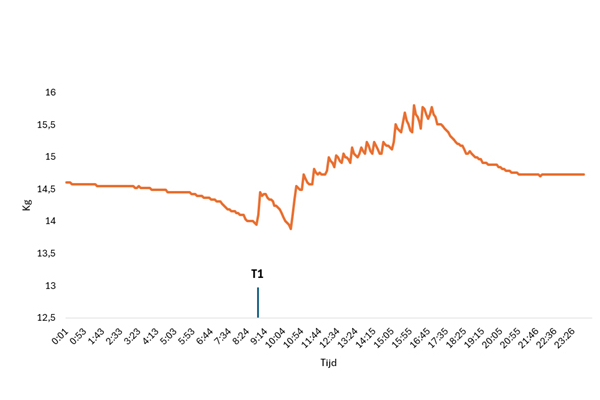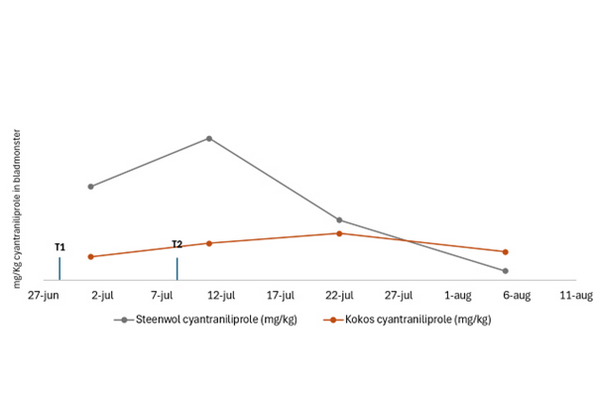At 'de Kas', Van der Knaap Group recently conducted a trial with crop protection agent Verimark from producer FMC. This research was set up in response to concerns from growers about the possible degradation or fixation of crop protection agents on coco substrate. This would potentially reduce the effectiveness of the pesticide. Although Van der Knaap has no negative experiences with the effectiveness of crop protection products on coco substrate, and many growers indicate in practice that pests such as aphids are effectively controlled, the company still wanted to establish this objectively in a controlled trial.
Trial
The study took place in a bell pepper crop (variety Alzamora RZ, planting date January 3, 2024) where researchers compared a stone wool substrate with a coco substrate. The research compartment was separated into twelve sections, in which both substrates were evenly distributed to minimize differences in greenhouse climate. Separate irrigation systems were installed for both substrates to ensure optimal watering.
In the greenhouse, researchers observed some hot spots of aphids before the start of the trial, with no clear preference for either substrate. To accurately assess the effectiveness of Verimark, they took leaf samples that were tested for the concentration of the active ingredient cyantraniliprole. The leaf samples were always taken from the same height, using leaves that were formed in the same week. Thus, for each analysis, older leaves were taken.
Implementation and circumstances
In consultation with Nico Harteveld of FMC, it was decided to carry out a block of two Verimark applications. This builds up the active substance in the plant, extends the duration effect, and reduces the chance of resistance. Both applications took place on days when researchers expected the plants to be active. The first application took place on June 28, 2024, at a light irradiation of 2400 J/cm² and a maximum outdoor temperature of 21.5°C. The second application followed on July 8, 2024, at 1800 J/cm² and a maximum of 22.3°C.
To optimize Verimark uptake, watering was stopped one hour earlier the day before the treatment. This caused the plants to inoculate extra that night, increasing the substrate uptake capacity. The Verimark application took place between 08:00 and 09:00, with 0.033 ml of Verimark per plant, dissolved in 150 ml of water. This dosage corresponds to the label recommendation of 33 ml per thousand plants. To avoid any variations between the two irrigation systems, Verimark was applied manually. After application, watering was interrupted for an hour to promote uptake. After this, the turn rate was halved until 15:00 to prevent drain generation. After this, we resumed our usual irrigation strategy.
The weight progression of the plants on the first day of treatment is shown in the attached graph, with the time of application marked 'T1'. The plants and the possibility of drain were closely monitored throughout the day, to adjust if the plants showed signs of plant sagging or drain formation. However, adjustments in watering did not prove necessary. No drain was observed on either treatment day.
 graph: weight distribution of Forteco Profit coco substrate in 'de Kas'
graph: weight distribution of Forteco Profit coco substrate in 'de Kas'
It is important to note that when this method is used in practice, growers should keep in mind that additional water may be required to ensure that the agent is distributed throughout the irrigation line.
Results
Aphid control was similar on both substrates. Four series of leaf samples were taken: three days after the first application, three days after the second application, fourteen days after the second application, and 28 days after the second application. It can be seen in the leaf samples (graph) that the initial concentration of the active ingredient in the plants on the stone wool substrate is higher than the plants on the coco substrate, but this concentration decreases faster on the stone wool substrate than on the coco substrate. Interestingly, the concentration of active substance in the coco substrate still increased slightly between the second and third measurements, without the application of an additional agent.
At the time of writing this article (week 36), no reinfection of aphids was observed on either substrate. This confirms the efficacy of the pesticide as an effective aphicide on both coco substrate and stone wool substrate.
 graph: a trial with Verimark in innovation center 'de Kas'
graph: a trial with Verimark in innovation center 'de Kas'
For more information: Van der Knaap
Van der Knaap
www.vanderknaap.info
